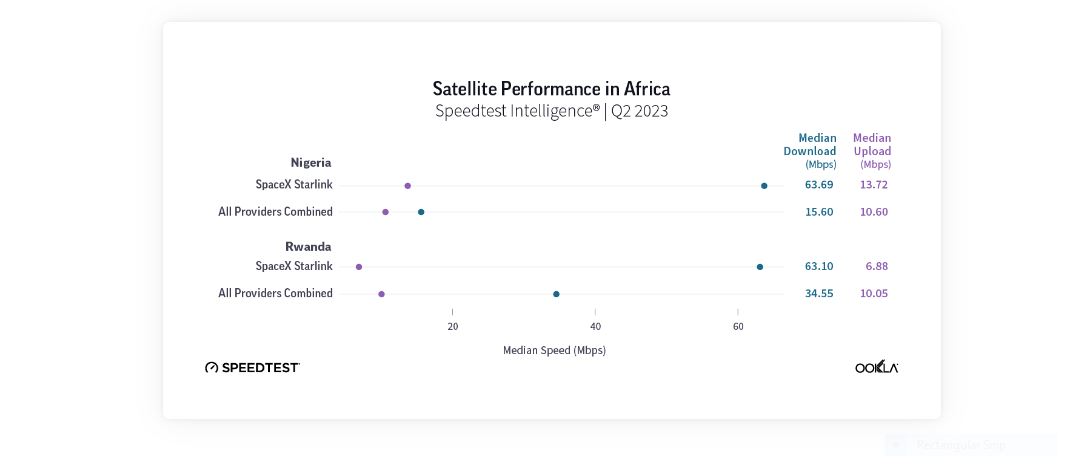- Starlink, SpaceX’s satellite internet service, has shown strong performance in Nigeria and Rwanda during the second quarter of 2023.
- In Nigeria, Starlink outperformed traditional fixed broadband providers, delivering a median download speed of 63.69Mbps.
- Starlink’s internet speeds were substantially faster than the combined median speed of all fixed broadband providers in Nigeria at 15.60Mbps.
Starlink, SpaceX’s satellite internet service, has shown strong results in Nigeria and Rwanda during the second quarter of 2023, in the fast-changing landscape of internet connectivity in Africa.
According to Speedtest Intelligence data, Starlink has outperformed traditional fixed broadband providers in terms of download speeds in Nigeria, while making notable strides in Rwanda despite some latency challenges.
Starlink in Nigeria
Starlink made its debut on the African continent in Nigeria in January 2023 and has already begun to make its presence felt. The Speedtest Intelligence data for the second quarter of 2023 revealed that Starlink users in Nigeria experienced median download speed of 63.69Mbps.
This figure significantly exceeded the combined median download speed of all aggregate fixed broadband providers, which stood at a mere 15.60Mbps during the same period. This substantial speed advantage positions Starlink as a game-changer for internet connectivity in Nigeria, Africa’s most populous country.
While upload speeds were more evenly matched, with Starlink recording 13.72Mbps and fixed broadband providers at 10. (https://poshsidekick.com/) 60Mbps, Starlink did display a slightly higher multi-server latency at 55.88ms compared to 50.26ms for fixed broadband providers.
Nevertheless, the impressive download speed demonstrates Starlink’s potential to revolutionise internet access in Nigeria. In January this year Starlink launched services in Nigeria, becoming the first African country to do so.
In Rwanda, Starlink also had a strong showing in the second quarter of 2023. The median download speed for Starlink users in Rwanda hit 63.10 Mbps, which is considerably higher than the combined median download speed of all fixed broadband providers at 34.55Mbps.
Starlink, however, lagged behind in terms of median upload speed, with 6.88Mbps compared to the 10.05Mbps offered by fixed broadband providers.
One notable challenge in Rwanda was the multi-server latency, where Starlink recorded a much higher latency of 320.45ms, whereas fixed broadband providers achieved a significantly lower latency of 29.04 ms during the same period. This latency issue indicates a potential area for improvement for Starlink’s performance in the region.
Starlink performance across Europe
Among European countries where Starlink is operational, Switzerland emerges as a clear frontrunner in terms of internet speed, boasting a blazing median download speed of 122.47Mbps. Switzerland is closely trailed by Denmark at 117.38Mbps, Austria at 111.91Mbps, and Belgium at 111.20 Mbps.
Continuing down the list of European nations with impressive Starlink speeds, Hungary, France, Ireland, Estonia, Portugal, and Latvia all deliver median download speeds exceeding 100 Mbps. Sweden, Italy, Bulgaria, and the United Kingdom also maintain respectable speeds, crossing the 100 Mbps threshold.
According to the survey, there is an interesting perspective on Starlink’s upload speeds across various European countries. Remarkably, in 25 out of the 27 countries surveyed, Starlink either maintained stable upload speeds or demonstrated improvements.
The survey reveals a fascinating range of upload speeds across the countries in question, with the majority falling between the 10Mbps to 15Mbps range. Portugal stands out as a leader in upload speed, boasting an impressive 17.70Mbps, followed closely by Hungary at 16.91Mbps, Croatia at 16.12Mbps, and several others including Bulgaria, Romania, Spain, and Poland, all with upload speeds above 15 Mbps.
Internet connectivity challenges in Africa
Starlink’s early successes in Nigeria and Rwanda suggest that satellite internet services could be a viable solution to address the connectivity challenges faced by many African nations. According to some estimates, there will be 58,000 satellites orbiting the Earth by 2030, representing an almost 725 per cent increase from 2023.
As reported by the Wall Street Journal, more than 362 million individuals in China currently lack internet access, accounting for approximately one-quarter of the country’s population. Many of these individuals reside in rural or remote areas. To bridge this connectivity divide, China is exploring the possibility of launching its satellite constellation, potentially consisting of more than 12,000 satellites.
While Starlink’s download speeds have shown remarkable superiority over traditional fixed broadband providers, challenges remain in terms of upload speeds and latency.

Read Also: Tanzania is set to allow Musk’s Starlink Satellite Internet Services.
Starlink spreading signal across Africa
In June, Sierra Leone joined the ranks as the fifth African nation to grant a license to Starlink, the satellite broadband service offered by SpaceX, the California-based aerospace company founded by billionaire entrepreneur Elon Musk. Starlink has already established its presence in other African countries, including Mozambique, Rwanda, and Mauritius.
On its website, Starlink invites potential customers in Kenya to seize the opportunity, exclaiming, “Order Starlink. Now Live in Kenya!” Their website promotes the availability of unlimited data and high-speed internet in Kenya for a monthly fee of $44.19 (KES6,500), with a one-time hardware cost of $605 (KES89,000).
Starlink asserts that its services are accessible throughout Kenya, even in the most remote and rural areas, providing a comprehensive solution for improved internet connectivity.
As per the Communication Authority of Kenya (CA), there has been a sustained surge in the adoption of mobile broadband services, driven by consumers’ increasing demand for faster internet speeds.
In their update for June 2023, CA reported that the total number of mobile devices in the country reached an impressive 62.96 million by March this year. This translates to a device penetration rate of 124.5 per cent, highlighting the prevalence of multiple devices per individual.
Kenya’s internet infrastructure
Further, the penetration rates for feature phones and smartphones stood at 66.2 percent and 58.3 percent, respectively, underscoring the widespread usage of advanced mobile technology. By March 2023, the overall international internet bandwidth available in Kenya grew by 20.4 per cent, totaling 14,413.053Gbps.
This increase was largely attributed to capacity upgrades on the TEAMS cable. Likewise, the usage of undersea bandwidth capacity surged by 25.5 percent, hitting 5,161.918Gbps, indicating a substantial expansion in Kenya’s internet infrastructure and connectivity capabilities.
As Starlink continues to expand its network and make improvements, it holds the promise of transforming internet access and bridging the digital divide in Africa, offering hope for better connectivity in underserved regions.











